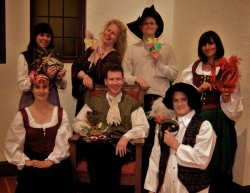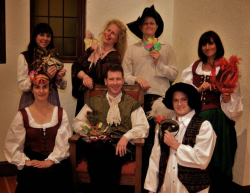
I headed out to the Inner Sunset Saturday night to Seventh Avenue Presbyterian Church to catch a concert of late Renaissance polyphony by the aptly-named San Francisco Renaissance Voices. The trip was made interesting by the very un-Presbyterian pre-Halloween revelers and the periodic outbursts from the neighborhood's various sports bars in response to the World Series game. Saturday’s music audience was assuredly a die-hard crowd.
The Renaissance Voices (SFRV) is a good community chamber choir with scrappy resources, and it would not be fair to write at length about the singers' limitations in vocal tone and phrasing. The sound had a fuzzy edge, leading to performances that were not as vigorous as they could have been. These are singers who love this music, and love to sing it, and I expect that they will grow and improve over time.
As expected, the group’s members exhibited variety in vocal technique; thankfully no single singer stuck out, not even the more accomplished ones. The choir maintained intonation throughout the evening to such an extent that it performed the 50-minute program of 13 movements without needing to re-pitch between movements. Also, in contrast to many community choirs, the women did not sound "mousy;" rather, they maintained a healthy and adequately open tone.
The evening's guest conductor, Don Scott Carpenter, is an organist who moonlights as the executive director of the American Bach Soloists, so he knows what a choir can sound like. Having not heard SFRV before, I was unsure how much he added or took away from the group's baseline. As a conductor he looks good, but he does have the odd bad habit of utilizing a tuning fork for a baton.
Carpenter's aesthetic favored a flowing line, and he always conducted in "big beats" (leaving the chorus to parse the rhythms and subdivisions of the phrases). Sometimes this was to the detriment of the musical phrasing, and, like many organists who direct choirs, he did not give quite the right amount of time for singers to breathe before phrases, or even pieces. He could have spent more time pointing up diction and musical affect to provide more excitement and contrast in a repertory prone to monotony.
The program itself centered on Tomas Luis de Victoria's old chestnut Missa O Quam Gloriosum (How glorious is the kingdom, a favorite of early music choirs) interspersed with motets from other countries to form a complete mass for All Saints Day. Featured composers included William Byrd and Ascanio Trombetti.
Happily, in contrast to other faux-Catholic masses-cum-concerts, we were spared the tedium of quasi-spiritual chant and parading choir members, which always mess up such attempts. The presentation was concise, appropriate, and tasteful, and the concert got out in time for me to catch the bottom of the ninth through a shop window while waiting for the train.

